The boom knuckle truck is a device designed to lift and distribute loads suspended from a hook. They are equipped with a means of propulsion able to produce the necessary movement to enable their movement on public roads and land.
Two different types of tail lifts dominate the market today: articulated and telescopic. Choosing the right platform lift for your project will make a difference in the efficiency, safety, and profitability of the task at hand.
Articulating booms are aerial work platforms with multiple boom sections that articulate, allowing the operator to access work areas over obstacles and barriers.
Telescopic booms are aerial work platforms with telescopically extending boom sections.
They are also commonly known as “stick” booms due to their straight appearance.
Telescopic booms offer greater horizontal reach than any other type of aerial platform, ideal for areas with limited access in construction, industrial, entertainment, road construction, bridge work, painting and inspection applications.
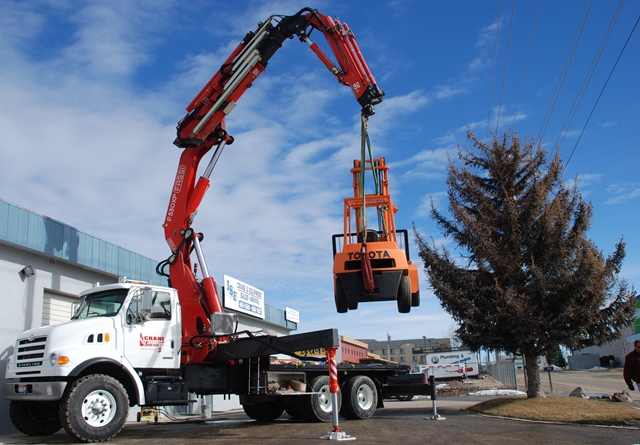
Truck mounted knuckle boom cranes
A boom truck (commercial truck-mounted crane) is defined as a crane consisting of a rotating superstructure (center post or turntable), a fixed or telescopic boom, operating machinery, and one or more operator’s stations mounted on a frame attached to a commercial truck chassis with a payload hauling capability whose power source powers the crane.
Its function is to lift, lower, and swing loads at various radii, requiring the use of outriggers/stabilizers.
Crane truck design:
In the case of the self-propelled knuckle boom truck, the unit can be divided into two distinct parts: supporting chassis and superstructure.
Crane carrier
The chassis is a metallic structure on which, in addition to the propulsion, steering and stabilization systems, the remaining components are fixed.
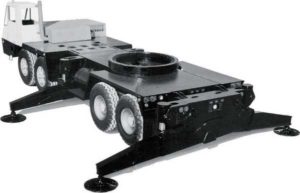
The superstructure
It is constituted by a base platform on the orientation crown that joins the chassis and allows the 360º rotation, which supports the telescopic boom, lifting equipment, control cabin, and counterweight if necessary.
Support elements
are those through which efforts are transmitted to the ground: caterpillars, wheels, and stabilizers or auxiliary supports that have mobile cranes on wheels.
They are constituted by hydraulic jacks mounted on extendable arms, on which the machine is fully rested, which allows to increase the surface of the lift polygon and improves the distribution of loads on the ground.
materials
Observing the catalogs of the cranes of different manufacturers it is known that telescopic booms are manufactured with high strength steel
Small Knuckle Boom Truck
The small knuckle boom crane has more than one cylinder inside. It usually has a rectangular shape, and its components are made of high durability and strength steel.
It is the element responsible for holding and varying the position of the elements that will manipulate the load.
It is the most requested component because it is responsible for resisting most of the efforts produced by the loads that are handled. It consists of four sections, with a length of 11 meters each, assembled inside each other in such a way that they can slide to vary the configuration of necessary length.
Inside it houses all the elements required to vary its extension. The dimensions of the profiles of the boom are determined by the bending, torsion, and compression efforts to which they are subjected and also by the mechanical properties of the material with which they are manufactured.
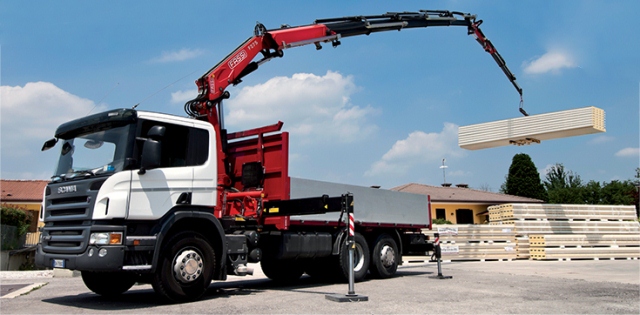
Telescopic boom lift
Type of profile:
Analyzing the current market, it can be observed that there is a tendency to stop using pens with rectangular section profiles to use profiles with more rounded sections.
It is known that the profile that is tried to obtain on the part of the manufacturers of cranes is a profile with the bottom oval.
The fact that some manufacturers do not yet use an oval profile is merely a matter of patents since Liebherr holds the patent for this type of profile.
Even so, the rest of the manufacturer’s design profiles are similar to the oval, respecting the rights of Liebherr.
The oval profile offers resistance to bending forces very similar to those that the rectangular profile can resist.
As for the torsional stress, the oval is more resistant than the rectangular one.
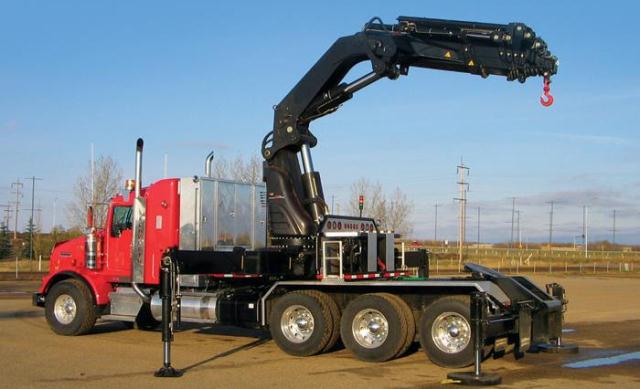
Telescoping boom lift
Stretches of the telescopic boom:
The dimensions of the sections start from the results obtained in the calculation of the annex, being a rectangular profile whose minimum dimensions are: a base of 600 mm, a height of 800 mm, and a thickness of 5 mm.
The profile has a rectangular geometric shape with rounded corners, as this will make it easier to assemble the different sections of the boom. Said profile contains holes in the upper part of each section of the boom that will allow the introduction of a bolt that will fix one section with another.
knuckle boom truck for sale
The articulated boom trucks for sale are manufactured with S1100 QL rectangular steel profiles with previously calculated dimensions and a thickness of 5 mm.
The calculation of the dimensions of the sheet is made taking into account the perimeter of the section to be made. The realization of the sections starts in a laser machine.
The first process in the cutting operation is to make the holes that the section to be manufactured has. Next, the marking of the areas where the force must be applied to produce the section bending is made and finally, the edges are cut with the necessary angle to be able to assemble it later.
When performing the cutting and marking operations, the sheet passes to another work station where the bending is done.
Folding is the most important operation in pen manufacturing. This process will provide greater or lesser mechanical resistance depending on the quality of execution.
In order to carry out the bending, hydraulic presses of a length such as to make the section of the pen in one piece are available; In particular cases, such as very long pens, several sections of the same section can be made and subsequently welded, thus achieving the desired length.
When the profiles have gone through the phases of cutting, marking and bending, they are prepared to be welded and assembled with the different parts that make up the boom of the crane.
When this process has been completed, the surface treatment and painting of the pieces is carried out to finally assemble all the components.
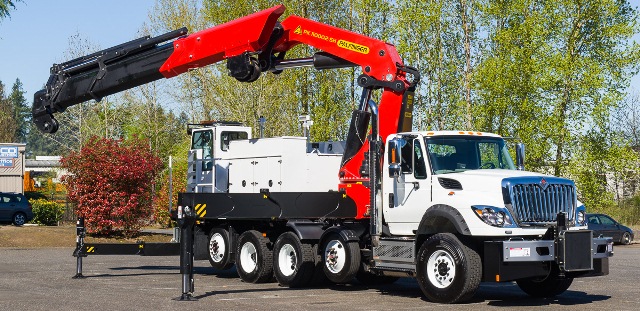
Rear-mounted knuckle boom truck mechanism
The material used in the sections of the boom is steel of high mechanical resistance.
This type of material is used due to the great efforts to which the pen is subjected from:
- The flexion produced when handling the load located at a certain distance from the anchor of the boom.
- The torsional stress that causes the acceleration of the load located at a certain distance, as well as the torsion produced by the load when the wind impinges on it.
This type of material will allow reducing the thickness of the sheet used in the manufacture of the profiles, thus reducing the weight of the boom considerably. The main elements of the crane are listed below:
Roller skates
The skids are elements that allow the sliding of the inner sections, reducing friction and providing a contact surface that allows distributing better the efforts produced by the manipulated loads.
They are placed next to the rounded corners of the profile. The skates are ideal elements to work on hard metal surfaces.
Each section has 8 runners, distributed so that there are four skates on the back of the boom and four skates occupying the front of it.
Its geometry is based on the section of the gap that is between one section and another, being 20 mm thick. They have a step that will serve to fix the skates on both the back and front that has the pen.
The fixing of the runners will be done by M16 screws. Both the skates and the covers have holes through which the screws that will join them will pass.
At the back of the boom, the skates will be attached to the inner profile, thus moving along the section that you wish to extend, while in the front the skate will be fixed to the outer section so that it will remain fixed.
Material of the skates
Polyamide skates will be used, which provides the following characteristics:
They do not need lubrication: The material incorporates solid lubricants linked to the molecular structure, which guarantees the presence of lubricant during the whole useful life of the piece, for this reason, they are ideal for areas of difficult access or where lubrication is problematic.
Easy and smooth movement: Since they present a null stick-slip effect (the stick-slip effect or also known as the oscillation phenomenon due to relaxation, is the spontaneous spasmodic movement that can occur while two objects slide over each other), which means that the start of the movement is smooth and controlled. (This is a fundamental characteristic of machinery whose objective is to elevate or transport pieces).
Excellent resistance to wear: Even without lubrication they last much longer than other substitute products.
Good load capacity: By presenting a large contact surface, the load is distributed more evenly.
Resistant to corrosion: they are ideal for external use, even in marine environments. In addition, the internal lubricant that they incorporate serves to protect the area of the pen by which they slide.
Rear covers
At the rear ends of the profiles, 200 mm thick plugs are welded whose function is to house the anchor bolts between sections in the upper part that will allow the union between the sections of the boom, besides locating two holes, one in each lateral from where the telescoping system will drag the sections to carry out the total or partial extension of the boom.
It is possible to differentiate the central hole, in the upper part, where the anchor bolt will be located, in addition to the lateral holes in the square section that will allow accommodating the drag bolts of the section.
Its internal geometry contains the same shape as the telescoping body, in order to fit perfectly in addition to providing a support base.
There is a vacuum of material between the external and internal top of the lid in order to be able to assemble both the upper anchor bolt and a spring that will be responsible for preventing the bolt from being dislodged from its operating position. These components will be explained in later chapters.
Front covers
These elements will allow fixing the skids and the covers of the skids by means of screws, thus allowing a good subjection.
Skate housings
In order to fix the skids of the front part, there are covers manufactured in steel 960 QL, see annex 3.26, in which there are holes placed in such a way that in their assembly they are concentric with the holes that the skids carry.
In this way, you can proceed to the assembly of the skids and covers by placing M16 screws. Four casings are available, corresponding to the number of skids that must be placed on the front, two on the top, and two on the bottom.
It has been decided to introduce these elements for reasons of resistance since it is not considered convenient to perform the joining of the skids by means of screws directly on them.
Feather head
This element is located at the front end of the telescopic boom, welded to the last section, and is responsible for holding the pulleys. Its geometry is designed so that the cable can not touch the pen at the time of tilting, so it has axes that separate both elements.
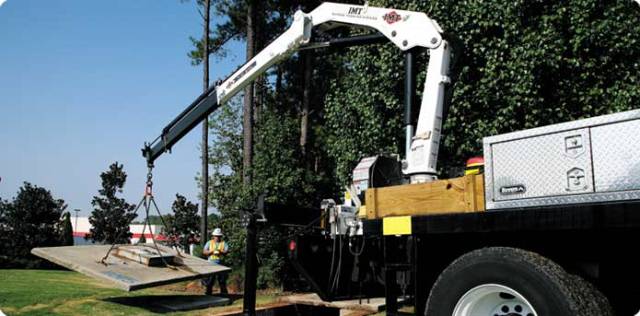
Assembly of the knuckle boom
The union of the front and rear covers will be done by means of welding to the profiles. However, the union of the skids and the housings for the skates with the covers will be carried out through screws.
Articulating boom crane design
Design of a articulating boom crane:
The design process:
- The design is defined as the previous process of mental configuration, “pre-figuration”, in the search for a solution in any field.
- The first decision that must be taken when designing a new production system is the design of the product that is going to be manufactured. The development of new products has become a key factor to achieve business success.
- In recent years there has been growing concern about the process of design and development of new products. And more specifically by reducing the time spent designing and developing new products.
- Therefore, developing new products in a short time, so that they are available as soon as possible in the market, becomes one of the main concerns of today’s companies.
- The importance given to the time of development of new products, as a factor of competitive advantage, has motivated one of the main concerns of those in charge of managing this process is to find a series of tools that help reduce this time.
- This process involves the realization of a complex set of activities, in which most of the functional areas of the organization must intervene.
Telescopic boom crane design
Design stage
Phases of the design process: Generally this development process is usually divided into five phases or stages.
Opportunities identification: Information is obtained on the needs and demands of the market, identifying existing opportunities, possible movements, and reactions of the competition, technical possibilities and manufacturing requirements. During this phase the design of the concept is fixed, the target markets are selected, the level of performance, the necessary resources and the foreseeable financial impact of the new product.
Evaluation and selection: those ideas are selected that present greater possibilities of success. This evaluation process involves an analysis of the viability of the product from different points of view.
Development and engineering of the product and the process: In this third phase, most of the detailed design and product development activities are carried out, as well as the production processes necessary for manufacturing and subsequent market launch.
Tests and evaluation: In this part, a particular behavior or set of objectives is measured before starting production.
Start of production: if the evaluation carried out in the previous phase is favorable, the product passes to the fifth phase in which large-scale manufacturing begins; the market launch of the new product, its initial distribution and operations to support it.
Crane structure design
This information is combined to establish the architecture of the new product.
The described development process is carried out in an iterative way until reaching the design that best suits the consumer’s needs. In each iteration, you learn about the problem to solve and the existing alternatives until the final design is converged and the specifications detailed initially are completed.
For the present project, the following design process will be followed:
- Approximate dimensions
- Predimensioning
- Efforts
- Tensions and deformations
- Testing
- Final resizing
- building
What does a boom truck do?
The main difference between a boom lift and vs crane is that boom lifts are used for lifting workers and their equipment to work sites at height. Boom cranes don’t have a bucket platform for holding workers. They are only used for lifting and moving extremely heavy loads.
The first aspect of a boom truck is a hydraulic crane, which allows workers to lift heavy and sometimes unconventionally shaped items from floor to roof. A flatbed provides the second aspect of the boom truck, and space for items to be transported to and from different areas of a site.
Aerial lift equipment is used in a wide range of industries on job sites and in facilities around the world. Boom lifts, in particular, are an ideal choice for applications where you need to lift workers, tools and materials extended heights to get the job done.
The most read

Knuckle Boom Crane
Knuckle boom cranes are an amazing piece of engineering technology. Also called a loader crane, articulating crane, and a picker crane, the knuckle boom crane has changed the way people load and offload in a variety of industries.
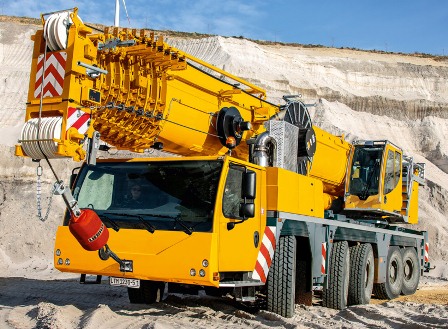
Mobile Crane Parts
Mobile Crane Parts: How does it work? types of industrial cranes, mobile, mobile, fixed, hoist, pulleys, hook. Chassis camion, Crane rotating mechanism
